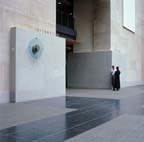
According to the Philadelphia, PA-based office of Bohlin Cywinski Jackson, the architectural firm responsible for the design, the building was created to accommodate both the technological needs for flexibility and adaptation and the critical human needs for interaction and permanence. With this in mind, the architects set out to provide a workplace of the future for government services while sensitively integrating a major new building into the fabric of Pennsylvania's historic Capitol Complex. Additionally, the design carves out a great public space that communicates the ideals of governmental openness, community spirit and civic awareness.
The placement of building elements such as entrances, the proportion of building facades, the extension of circulation axes and the use of enduring materials reinforce the traditional architectural principles of the existing Capitol Complex. Honed gray Indiana limestone from Indiana Limestone Co. of Bedford, IN, was selected for the facade of the building and flame-finished Woodbury granite from New England Stone LLC of North Kingston, RI, was utilized around the base of the building.
The south facade mirrors the exterior of the office building across the street in its height and massing, establishing stone belt courses that extend around the entire perimeter. Responding to other adjacent structures, the building aligns its heights, setbacks and forms to unify the composition of surrounding buildings. On the east and west facades, sunscreens made of vertical limestone fins float in front of glass curtain walls. In a nod to the circular State Museum that shares a major public plaza, the curtain wall and limestone fins on the west facade curve slightly inward. On the north, the building is set back from the street to align with the face of the adjacent building to the east, allowing the extension of the landscaped character of the complex and integrating the tall monolithic State Archive building tower to the northwest into the spatial composition.
Furthermore, limestone and granite surfaces extend into the interior where they are augmented with maplewood in the most public areas. The office wings look down into the atrium from above a limestone wall punctuated by the entrances, interior window openings, limestone piers and stone benches. The benches have carved, contoured limestone backs and honed finished Woodbury granite seats. Granite detailing flanks the reception area, extending as a wall behind the honed finished Woodbury granite information center. The diffused light that cascades through the atrium from the fritted glass roof plays softly on the surface of flame and honed finished Laurentian Green granite pavers of the floor.
According to Corky Cost of Cost Co., the contractor on the job, the stonework took approximately 150 workers a total of 14 months to install. Cost said that the most difficult part of the project was dealing with the limestone fins. “The material handling was extremely difficult,†he said. “It was clumsy and hard to work with.†Overall, he said everyone was happy with the results of the project, as it was well received by all.
With sensitivity to scale and to history, and attention to humane details that even extends to components people touch, such as hardware, railings and benches, the architects created a building unique in its response to its site and circumstances.

Credit Box
Keystone BuildingHarrisburg, PA
Architect: Bohlin Cywinski Jackson, Philadelphia, PA
Contractor: Cost Co., Pittsburgh, PA
Stone Suppliers: Indiana Limestone Co. Bedford, IN (Indiana limestone); New England Stone LLC, North Kingston, RI (Woodbury granite, Laurentian Green granite)